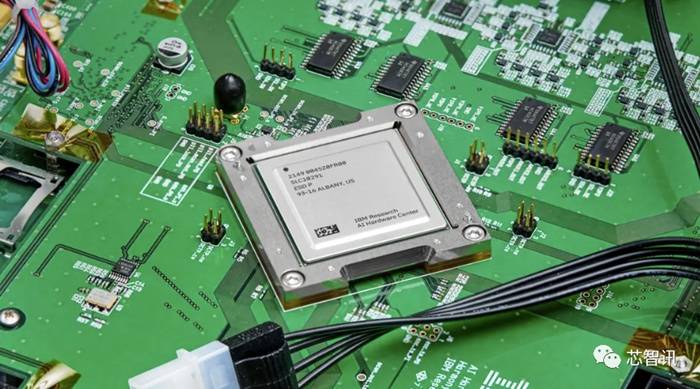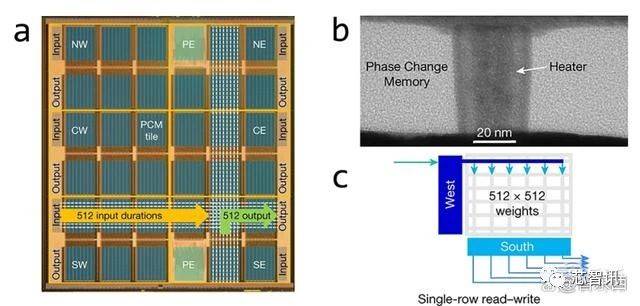 Technology peripherals
Technology peripherals
 AI
AI
 IBM cooperates with Macronix to launch a new AI simulation chip, which is 14 times more energy efficient and equipped with phase change memory technology
IBM cooperates with Macronix to launch a new AI simulation chip, which is 14 times more energy efficient and equipped with phase change memory technology
IBM cooperates with Macronix to launch a new AI simulation chip, which is 14 times more energy efficient and equipped with phase change memory technology
IBM Research Laboratory released its latest research results in the journal Nature on August 23, successfully developing a new artificial intelligence (AI) simulation chip. The energy efficiency of this chip is 14 times that of traditional digital computer chips, which can significantly reduce the power consumption of AI computing

This content is rewritten as follows: According to the abstract, current artificial intelligence models with billions of parameters can achieve high accuracy in a variety of tasks, but also highlight the limitations of traditional general-purpose processors (including graphics processors and central processing units). Processor, etc.) low performance problem. In order to solve this problem, the IBM research team proposed a "simulated memory computing" solution to provide higher energy efficiency by performing matrix-vector multiplication in parallel on its own memory
IBM's research team developed a 14-nanometer analog chip based on this solution, using 34 large phase change memory (PCM) arrays, combining digital-to-analog conversion input, analog peripheral circuits, analog-to-digital conversion output and large-scale Parallel 2D mesh routing. Each 14-nanometer chip can encode 35 million PCMs, and in a scheme where each weight corresponds to 2 PCMs, 17 million parameters can be accommodated. Combined, these chips can handle real-world AI application experiments as effectively as digital chips

During the test process, IBM's research team used Google speech detection and Librispeech speech recognition data sets to respectively test the efficiency of the chip's language processing capabilities
The IBM team proposed a convolutional neural network architecture for keyword speech detection and trained it using a Google voice command data set containing 12 keywords. The team adopted a simpler FC (fully connected) network structure, ultimately achieving a recognition accuracy of 86.14%, and the submission speed was 7 times faster than the current best case of MLPerf. The model is hardware-aware trained on the GPU and then deployed on the team’s simulated AI chip
On the larger Librispeech speech recognition dataset, we used a combination of 5 simulated AI chips to run an RNN-T (Recurrent Neural Network Transformer) model to transcribe speech content letter by letter. The system, which contains 45 million weights from 140 million PCM devices on five chips, is able to capture and transcribe the audio of people speaking with an accuracy very close to that of a digital hardware setup. After experiments, we finally achieved a word error rate of 9.258%, and the energy efficiency reached 6.704TOPS/W (one trillion operations per second/watt), which is 14 times higher than the current best energy efficiency of MLPerf
The phase change memory equipped on this AI chip was jointly developed by IBM and Macronix, which requires attention
According to our understanding, the cooperation between Macronix and IBM has a long history. As early as 2004, the two parties established a strategic cooperation alliance and jointly invested in the development of phase change memory for more than ten years. Although other competitors initially joined, over time many manufacturers have withdrawn from joint R&D cooperation. Currently, Macronix is the only partner of IBM phase change memory and has obtained specific artificial intelligence-related authorization
Currently, Macronix and IBM are jointly developing plans for phase change memory. This plan will be carried out in one phase of three years. After the expiration, the two parties will sign a new joint development contract according to the situation. Both parties have realized the unlimited business opportunities brought by artificial intelligence, so they have targeted the cooperation direction of phase change memory towards artificial intelligence applications. The most recent contract was signed in October 2021, and Macronix also announced relevant content through major information
Macronix announced at the time that the company would continue to participate in IBM's phase-change memory joint development plan and had obtained authorization for specific analog artificial intelligence technology. The contract is valid from January 22, 2022 to January 21, 2025. During the cooperation period, Macronix will assume confidentiality obligations and jointly share research and development costs, while complying with U.S. export control laws and other related obligations. The specific purpose of this cooperation is to continue investing in the development of advanced technologies and have a positive impact on Macronix’s technology and competitiveness
Phase change memory is analyzed by industry insiders as having characteristics such as fast speed, non-volatility, and low power, making it an ideal choice for high-density memory that can fill the price and performance gap between DRAM and NAND required for AI servers. Gap
Regarding the latest progress in cooperating with IBM on phase change memory, Macronix stated on the 29th that the project is proceeding smoothly and the development direction of advanced applications such as AI has been determined
Rewrite the content without changing the original meaning. The language needs to be changed to Chinese. No need to appear the original sentence
The above is the detailed content of IBM cooperates with Macronix to launch a new AI simulation chip, which is 14 times more energy efficient and equipped with phase change memory technology. For more information, please follow other related articles on the PHP Chinese website!

Hot AI Tools

Undresser.AI Undress
AI-powered app for creating realistic nude photos

AI Clothes Remover
Online AI tool for removing clothes from photos.

Undress AI Tool
Undress images for free

Clothoff.io
AI clothes remover

Video Face Swap
Swap faces in any video effortlessly with our completely free AI face swap tool!

Hot Article

Hot Tools

Notepad++7.3.1
Easy-to-use and free code editor

SublimeText3 Chinese version
Chinese version, very easy to use

Zend Studio 13.0.1
Powerful PHP integrated development environment

Dreamweaver CS6
Visual web development tools

SublimeText3 Mac version
God-level code editing software (SublimeText3)

Hot Topics
 Best AI Art Generators (Free & Paid) for Creative Projects
Apr 02, 2025 pm 06:10 PM
Best AI Art Generators (Free & Paid) for Creative Projects
Apr 02, 2025 pm 06:10 PM
The article reviews top AI art generators, discussing their features, suitability for creative projects, and value. It highlights Midjourney as the best value for professionals and recommends DALL-E 2 for high-quality, customizable art.
 Getting Started With Meta Llama 3.2 - Analytics Vidhya
Apr 11, 2025 pm 12:04 PM
Getting Started With Meta Llama 3.2 - Analytics Vidhya
Apr 11, 2025 pm 12:04 PM
Meta's Llama 3.2: A Leap Forward in Multimodal and Mobile AI Meta recently unveiled Llama 3.2, a significant advancement in AI featuring powerful vision capabilities and lightweight text models optimized for mobile devices. Building on the success o
 Best AI Chatbots Compared (ChatGPT, Gemini, Claude & More)
Apr 02, 2025 pm 06:09 PM
Best AI Chatbots Compared (ChatGPT, Gemini, Claude & More)
Apr 02, 2025 pm 06:09 PM
The article compares top AI chatbots like ChatGPT, Gemini, and Claude, focusing on their unique features, customization options, and performance in natural language processing and reliability.
 Is ChatGPT 4 O available?
Mar 28, 2025 pm 05:29 PM
Is ChatGPT 4 O available?
Mar 28, 2025 pm 05:29 PM
ChatGPT 4 is currently available and widely used, demonstrating significant improvements in understanding context and generating coherent responses compared to its predecessors like ChatGPT 3.5. Future developments may include more personalized interactions and real-time data processing capabilities, further enhancing its potential for various applications.
 Top AI Writing Assistants to Boost Your Content Creation
Apr 02, 2025 pm 06:11 PM
Top AI Writing Assistants to Boost Your Content Creation
Apr 02, 2025 pm 06:11 PM
The article discusses top AI writing assistants like Grammarly, Jasper, Copy.ai, Writesonic, and Rytr, focusing on their unique features for content creation. It argues that Jasper excels in SEO optimization, while AI tools help maintain tone consist
 Choosing the Best AI Voice Generator: Top Options Reviewed
Apr 02, 2025 pm 06:12 PM
Choosing the Best AI Voice Generator: Top Options Reviewed
Apr 02, 2025 pm 06:12 PM
The article reviews top AI voice generators like Google Cloud, Amazon Polly, Microsoft Azure, IBM Watson, and Descript, focusing on their features, voice quality, and suitability for different needs.
 Top 7 Agentic RAG System to Build AI Agents
Mar 31, 2025 pm 04:25 PM
Top 7 Agentic RAG System to Build AI Agents
Mar 31, 2025 pm 04:25 PM
2024 witnessed a shift from simply using LLMs for content generation to understanding their inner workings. This exploration led to the discovery of AI Agents – autonomous systems handling tasks and decisions with minimal human intervention. Buildin
 AV Bytes: Meta's Llama 3.2, Google's Gemini 1.5, and More
Apr 11, 2025 pm 12:01 PM
AV Bytes: Meta's Llama 3.2, Google's Gemini 1.5, and More
Apr 11, 2025 pm 12:01 PM
This week's AI landscape: A whirlwind of advancements, ethical considerations, and regulatory debates. Major players like OpenAI, Google, Meta, and Microsoft have unleashed a torrent of updates, from groundbreaking new models to crucial shifts in le





